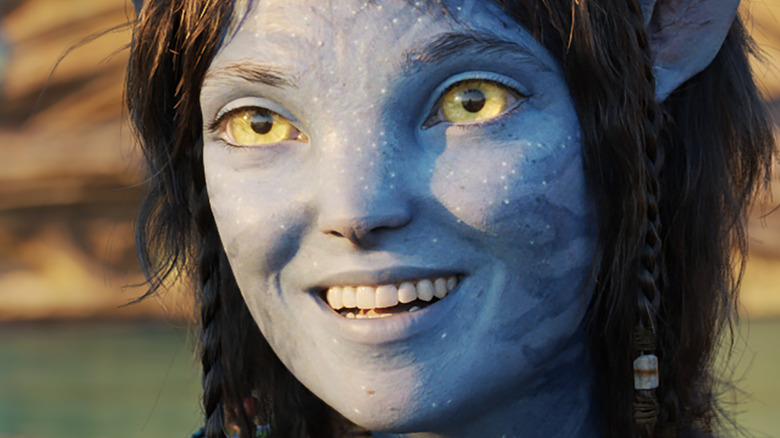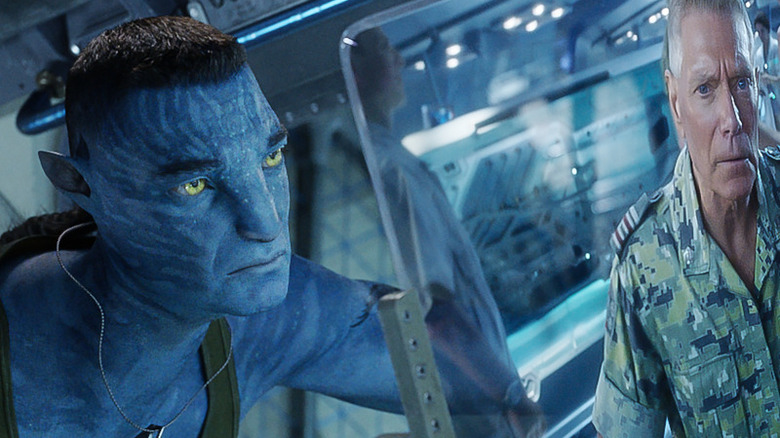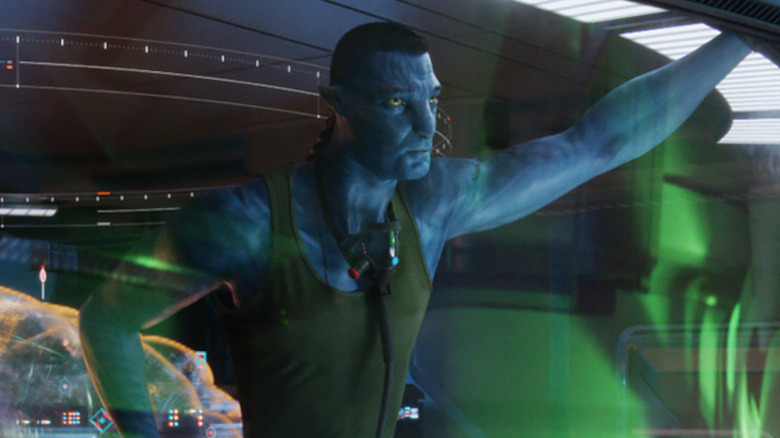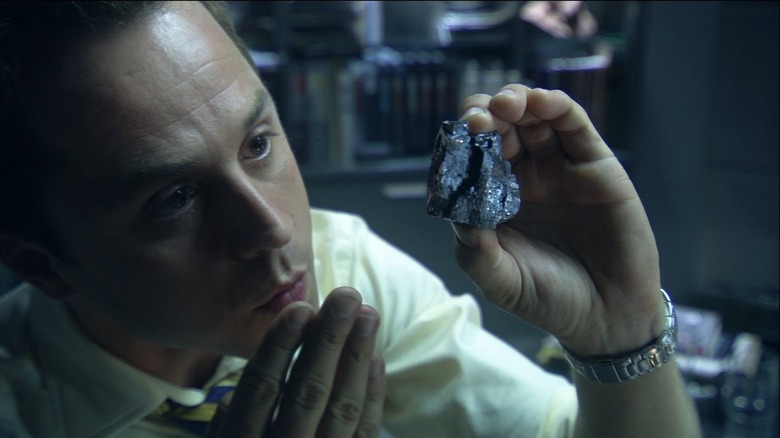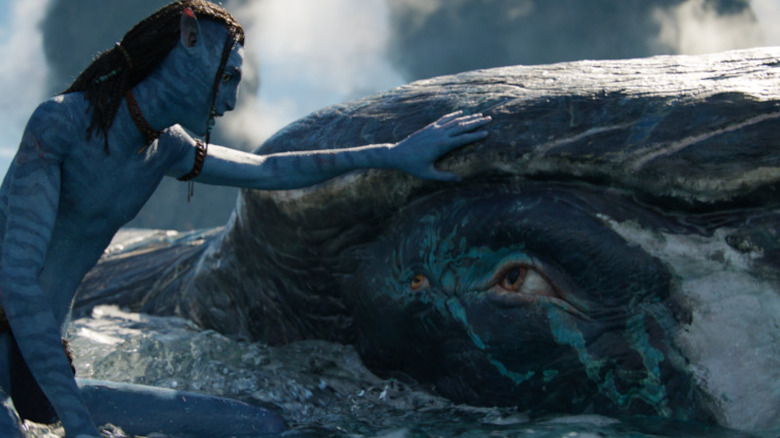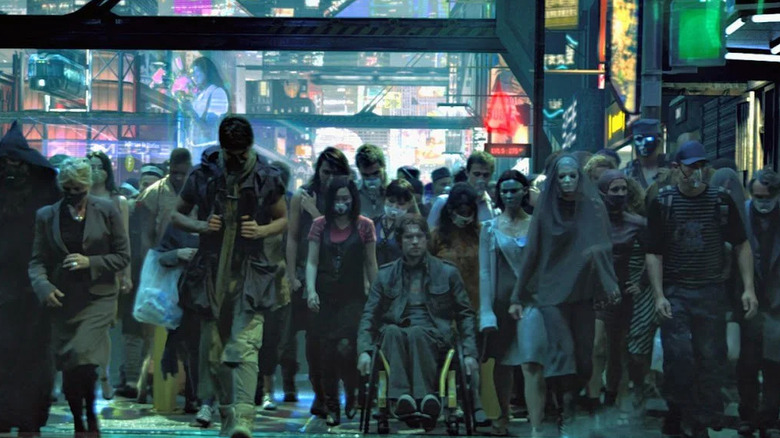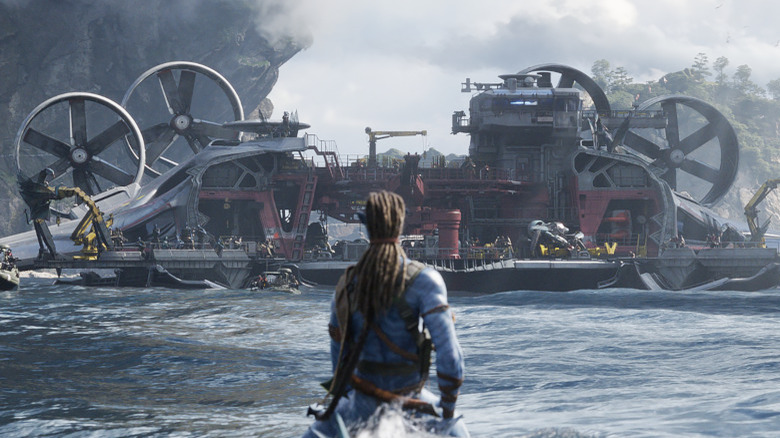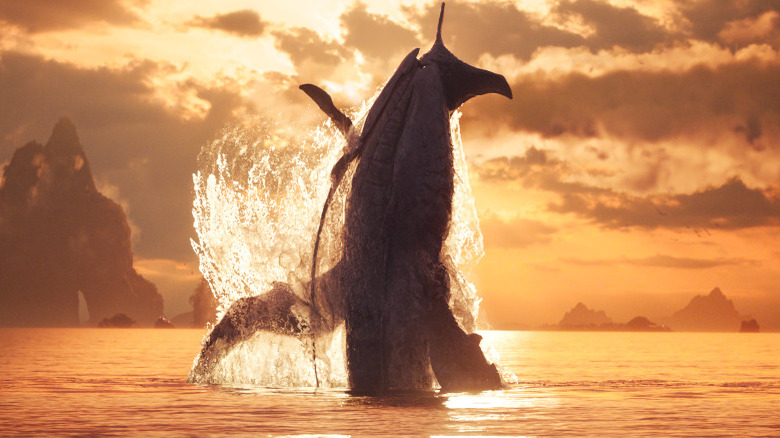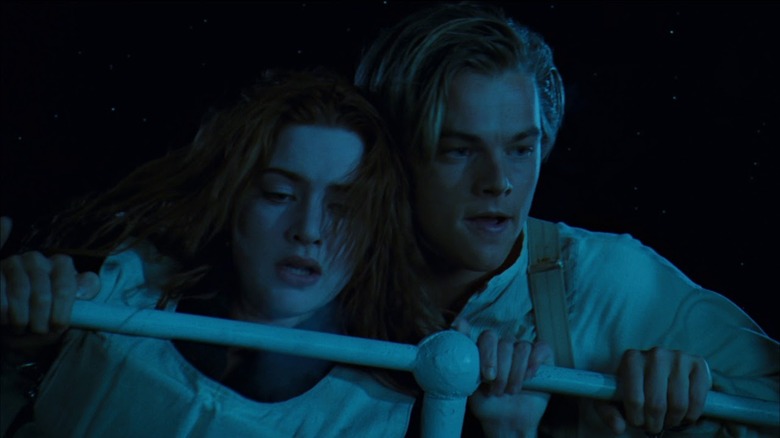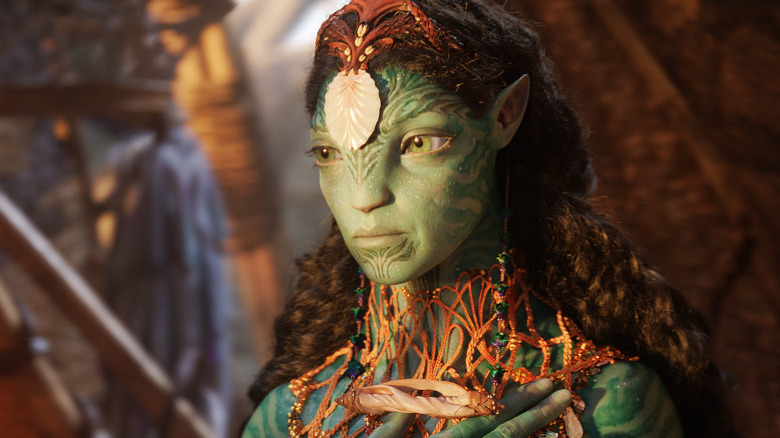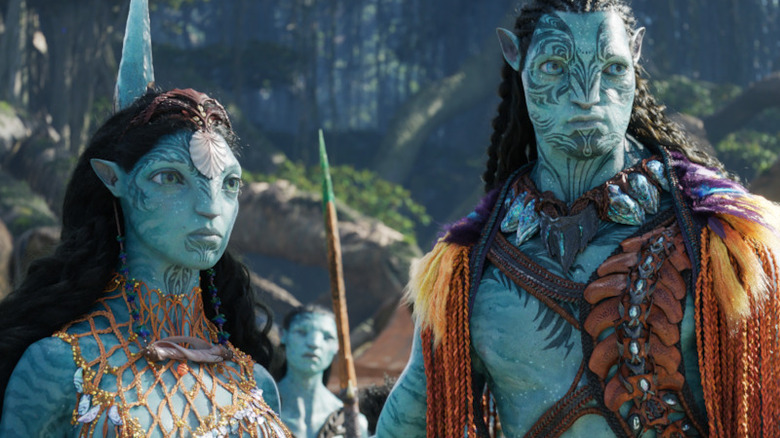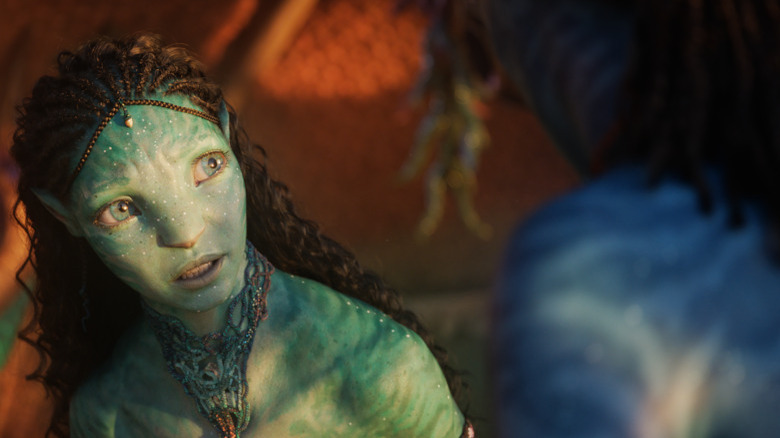Small Details You Missed In Avatar: The Way Of Water
This post contains spoilers for "Avatar: The Way of Water"
James Cameron is an undeniable visionary and masterful director. He is responsible for writing and directing some of the most iconic films of the last 40 years across several genres. His legendary credits include the first two "Terminator" films, the action-packed "Alien" sequel "Aliens," the period epic "Titanic," and, of course, 2009's multi-billion dollar grossing and cinematically groundbreaking "Avatar." While there are some (honestly deserved) criticisms of the original "Avatar" film, it's also true that it was a technological marvel at the time, pushing photoreal digital effects and 3D projection technology to its limit. The ripple effects from the tech created for Cameron's "Avatar" film are still being felt to this day.
The story of "Avatar" itself is set in the far future and follows Earth soldier Jake Sully (Sam Worthington), who is sent to the world of Pandora to help subdue the native Na'vi — that is, a community of nine-foot-tall blue cat-people — by putting his mind into the body of a Na'vi himself and using the body as an eponymous "avatar." However, he falls in love with another Na'vi, a beautiful warrior named Neytiri (Zoe Saldana), and decides to join the Na'vi in their fight against the Earth invaders. The sequel, "Avatar: The Way of Water," follows Jake and Neytiri's half-human/half-Na'vi children.
Since another important aspect of Cameron as a filmmaker is his meticulous attention to detail and relentless pursuit for perfection, there are some small details you might have missed while watching the film. Let's break those down below.
Capitalist Earth makes you work, even after death
Most of James Cameron's previous films have an anti-capitalist — or at least anti-corporate — stance within the film's narrative. In the previous "Avatar" film, this was shown through the banal, but nonetheless coldly malicious, machinations of the Resources Development Administration (RDA) as they tried to kill off all the Na'vi "hostiles" and hollow out the natural resources of Pandora by enlisting a paramilitary unit, led by Stephen Lang's Colonel Miles Quaritch.
In one of the less inspired aspects of "Avatar: The Way of Water," James Cameron, alongside co-writers Rick Jaffa and Amanda Silver, bring back Stephen Lang as Colonel Quaritch — who famously died at the end of the first film — as the sequel film's main antagonist once again. They explain away Quaritch's inexplicable resurrection by stating that RDA had stored his memories onto a disk prior to the first film's mission, in case he were to die. And, since he did die at the end of the first film, his memories were put into a Na'vi avatar to return to Pandora and finish the mission he started years later.
This brings up another example of the evils of untethered capitalism and corporate power in the dystopian future of "Avatar": you still have to work for the company even after you die. In "Avatar: The Way of Water," Quaritch, now a Na'vi, doesn't seem too disturbed by this revelation himself, as he has a personal vendetta against Jake Sully and wants revenge. However, the existential dread of how bad the labor conditions on Earth have to be to allow infinite forced employment are nonetheless palpable and terrifying.
There's a Hamlet reference with Colonel Quaritch's skull
At one point, the newly-resurrected Na'vi clone version of Colonel Quaritch returns to the place where Jake Sully and Neytiri had killed him in his original human form at the end of the first "Avatar" film. Since many years have passed since his death, Quaritch's human body has now decomposed into a rotting skeleton. Na'vi-Quaritch then picks up his dead human skull, holding it up in an obvious reference to the "Alas, poor Yorick" monologue from William Shakespeare's "Hamlet," when Hamlet himself holds up the skull of the king's jester Yorick.
This isn't just a simple visual allusion either. The "Alas, poor Yorick" speech that the eternally-distraught Hamlet gives in his eponymous play, is actually about the existential dread of one's inevitable death as well as the futility of life itself. Hamlet had fond memories of Yorick, and as he holds Yorick's skull in his hand, he laments what he sees as a waste of life.
So, too, does Quaritch as he holds his own human head in his now-Na'vi hands. He is literally seeing the futility of his past life, as well as the inevitability of his own death, since it already happened. He attempts to come to terms with it, but then decides to crush the skull in an act of defiance to the blatant symbolism of fate and the natural order of the life-death cycle. Of all the things used to describe Cameron's writing and directing style, "subtlety" is not one of them.
Giovanni Ribisi makes a cameo as Parker Selfridge
In the first "Avatar," actor Giovanni Ribisi played the corporate villain Parker Selfridge, who was the head of the Earth-based RDA that was seeking Pandora's sacred unobtainium. He was essentially the main antagonist of that film, alongside Stephen Lang's aforementioned Colonel Quaritch, and in may ways, he was worse the Colonel, as Selfridge was the head of the operation while Quaritch was just muscle. Selfridge himself represented the banal evils of bureaucratic corporate greed, becoming the slimy personification of unchecked capitalism and colonialism, much in the same way Paul Reiser's Carter Burke was in Cameron's previous sci-fi action film "Aliens."
Ribisi's Selfridge is not a major character in the sequel, "Avatar: The Way of Water" — the character was cast out of Pandora at the end of the aforementioned first film. However, he does have a blink-and-you'll-miss-it cameo in the film nonetheless. His appearance occurs towards the beginning of the film, while Colonel Quadritch's recently-awakened Na'vi clone watches a recording from his human-self in the past, who explains how he got his memories implanted into the new Na'vi avatar body. In the recording, Selfridge is seen in the background, correcting Quadritch and detailing the technology behind the memory-transfer process, which annoys the Colonel. It's a humorous scene. It also shows how Ribisi's presence is also missing in the sequel, as he wasn't a lovable character by any stretch of the imagination, but he was a character audiences loved to hate.
Humans are killing hordes of tulkun for just one thing
When James Cameron's original 2009 "Avatar" film was first released in theaters, one of the chief complaints was that it was basically "Dances with Wolves," but with blue space aliens instead of Native Americans. And, honestly, it's kind of hard to deny this comparison when watching the film itself (to the point that Cameron himself doesn't even deny it, per Gizmodo). Both films are about a soldier from a colonizing force falling in love with the Indigenous people and deciding to fight his own kind to protect them. Furthermore, both films talk about how most Native cultures would use the entire animal after a hunt — utilizing the animal's meat to eat, their hide to make clothes, their bones to make tools, and more.
"Avatar: The Way of Water," unsurprisingly, has many breathtaking sequences in it. One of the most harrowing sequences in the film is a chase scene on the Pandoran ocean between a massive RDA hunting vessel and a herd of sentient alien whale-like creatures called "tulkun." It is an obvious allusion to the inhuman and cruel whaling practices, as we the RDA hunting crew using their advanced sci-fi technology to violently corner, trap, and kill an entire family of tulkun. It is also reminiscent to the way European colonizers in the West would hunt animals, like the buffalo, to near extinction for their hides, while letting the corpses rot and with no care for the wider ecosystem (via The Atlantic). Furthermore, while the giant tulkun are hunted mercilessly, it's only so that the company can extract just one, single vial of brain goop, leaving the rest of the tulkun carcasses to rot and untouched.
Humans trying to live forever is a possible reason for Earth's downfall
What's interesting about "Avatar: The Way of Water" is that, besides some off-hand mentions, the plot of the film is no longer predicated on extracting the goofily-named element unobtainium from Pandora anymore. Instead, the RDA is attempting to completely terraform Pandora for human occupation, since in the ensuing years since the first "Avatar" film, it seems Earth has become completely inhabitable (rather than just mostly uninhabitable).
We don't spend a lot of time on Earth, but it seems one of the main issues with the planet in the "Avatar" universe is that it's overcrowded. However, there is an explanation given to why that is in "Avatar: The Way of Water" that isn't simply Malthusian (i.e. racist and classist): Once again, corporate greed and unregulated capitalism is the problem. See, during the previously-mentioned tulkun hunting scene, we discover the tulkun brain-goop is used to completely stop aging in humans.
This means that there is a population of people on Earth who are essentially immortal, assuming they can afford the goop. Adding to the fact that workers can seemingly have their memories scanned to constantly be re-cloned as an infinite labor force, it seems the company's short-sighted, profit-motivated, and anti-labor policies are dooming Earth.
This also goes against the balancing of energy that the Na'vi follow on Pandora. They say the Goddess Eywa gives energy for life, but that it is only borrowed, and that you end up giving the energy back in death. However, humans on Earth (presumably rich humans) are trying to hoard their life — and their energy — and not giving back it back to nature, causing disruption, chaos, and destruction on their planet in the process.
Earth tech is reminiscent of Cameron's real deep sea dives
It's no secret that "Avatar: The Way of Water" director and co-writer James Cameron is obsessed with the ocean (via National Geographic). He has spent tons of money from his own personal fortune into funding deep sea expeditions — including many trips to the long-lost sunken wreck of the Titanic for research on the film of the same name. In fact, the modern framing device about "The Heart of the Ocean" blue diamond with Bill Paxton and Gloria Stuart as "Old Rose," was loosely based on Cameron's own experiences as a deep sea diver and researcher.
So, it's no surprise that some of that design aesthetic for the RDA's tulkun hunting operation would have some aesthetic similarities to his previous experiences on ships and subs himself. Even the more fantastical sci-fi designs — such as the subs that have metallic crab-like legs and mechanical claws — bare resemblances to real tech in the field of deep sea diving. It's clear just as much love and care went into the designs of the Earth tech, as it was of Pandora's ocean wildlife.
Free Willy references
As mentioned above, James Cameron is obviously obsessed with the ocean, and the various aquatic life that inhabits it. This includes the aforementioned whale-like tulkun, who live in the ocean and visit the coastal villages of the marine-based Metkayina Na'vi tribe. The Metkayina and the tulkun share a close, sacred bond, as the tulkun are revealed to be sentient creatures — arguably smarter than both the humans and Na'vi — who are even capable of complex language, mathematics, and even art.
At one point, Jake's younger son Lo'ak (Britain Dalton) befriends a wounded and "banished" tulkun. Throughout the rest of the film, Lo'ak and the banished tulkun swim together and grow a close and special bond themselves. The tulkun even becomes pivotal to the Na'vi winning the final battle against the large tulkun-hunting ship.
This subplot seems to be similar to the plot of the 1993 family film "Free Willy," about a young boy (Jason James Richter) who befriends a mistreated marine animal — in the case of "Free Willy," an orca — and then gives the creature purpose to, well, free it. Not only that, but there are seemingly overt visual references to the film, such as a slow-motion shot of it climatically jumping in the air set right before Pandora's daily eclipse (essentially, "Golden Hour" sunset) that is very close to the visuals of "Free Will."
To be fair, both "Free Willy" and Lo'ak's subplot in "Avatar: The Way of Water" are what TV Tropes would define as "A Boy and His X" story, so it's likely they're both drawing from the same classic template. However, it also makes sense that "Avatar" would also reference another well-made version of the same story as well.
The climax sequence is visually reminiscent of Titanic sinking
The climax of "Avatar: The Way of Water" is set during a battle on top of the ocean, where the entire Sully family fights off Quaritch and his recently Na'vi-ified Marine goons on the massive deep sea tulkun-hunting vessel. Eventually, the raging battle eventually creates enough structural damage to the ship to cause it to flip upside down throughout the rest of the scene. This, of course, lets the ocean water to flood inside the ship as it rapidly topsides and sinks with the family stuck inside.
During this exciting sequence, there are many shots and situations that are very eerily similar to James Cameron's previous action-packed epic set in the ocean, "Titanic." This includes water rushing down hallways, blasting down doors, and flooding kitchen and engine areas. The scenes where two characters — whether it's Jake and Lo'ak, or Neytiri and their youngest daughter Tuktirey — who are neck deep in water, about to drown. We suppose James Cameron thought, "why mess with perfection?"
Re-casting Kate Winslet from Titanic in a major role
Speaking of James Cameron's '97 historical blockbuster epic "Titanic," another returning element from that film is the director re-casting star Kate Winslet (who played Rose, the female lead of "Titanic") as the Metkayina Queen Ronal in "Avatar: The Way of the Water." Cameron often likes to bring actors he's worked with before on different projects, such as Bill Paxton appearing in "Terminator," "Aliens," "True Lies," and "Titanic," as well as working on multiple films with star Arnold Schwarzenegger and Sigourney Weaver (herself appearing in both "Avatar" films).
However, there had been some tension between director James Cameron and Winslet from their turbulent time working together on the stressful and disaster-prone "Titanic" set. Luckily, they've since been able to bury the hatchet and finally work together after almost 30 years on the long-awaited "Avatar" sequel (via Deadline).
Meanwhile, Ronal is a strong and powerful character, who is the Metkayina who is the most wary of helping and giving sanctuary to Jake Sully and his family (which, honestly, proves prescient later on in the film). Winslet, of course, kills it as always, and we're looking forward to her continuing adventures in the "Avatar" saga, especially since it seems "Avatar 3" is mostly already filmed (via People).
Inter-tribe tensions reassemble real-life history
James Cameron's "Avatar" series has been seen (even by Cameron himself) as a sci-fi version of revisionist Westerns like "Dances with Wolves" and "At Play in the Fields of the Lord." All these films have a sympathetic view of Native Americans and their struggles against violent and genocidal colonization from European settlers, but they also usually show things from a white person's outside perspective. Even worse, they often fall into problematic "white savior" and "noble savage" narrative tropes, with "Avatar" unfortunately being no exception.
While "Avatar: The Way of Water" doesn't necessarily alleviate that problem all the way, the fact that Jake Sully's been fully-integrated for years helps the narrative stay focused solely on the Na'vi's own perspective at the very least. This includes more backstory on the intricacies of the politics between the various native tribes on Pandora. For instance, there's initially immense tension between Jake's family — who hail from the forest Omaticaya clan — when they first meet with the aquatic Metkayina tribe.
It's true "Avatar" isn't entirely one-to-one with real-life history, but this animosity between the different Na'vi clans is reminiscent of how many Native American tribes were warring with each other, and had trouble working together due to their past tension (and sometimes even siding with the colonists) during the European invasion (via National Geographic). Frankly, the continual inter-tribal conflict is arguably one of the biggest reasons that the Indigenous resistance ended up not being very successful.
Skin colors are slightly different between two Navi tribes
Besides the aforementioned historical echoes from our own reality, the tension between the Omaticaya and Metkayina seen in "Avatar: The Way of Water" is, unfortunately, also due to the fact that — like humans — the Na'vi can be biased based on unchangeable physical differences between each other.
This is mostly due to the fact that the Metkayina Na'vi have evolved, seemingly for thousands — if not millions — of years to survive near the oceans of Pandora, which means that their bodies have adapted specifically for that environment. This includes thicker, turtle-like forearms, long and thicker tails, and stronger diaphragms to swim better. Meanwhile, the forest-based Sully family are more lithe and thin to make climbing and running through trees easier.
Beyond those relatively obvious physical differences between the forest and water Na'vi, another difference that exists — but is not really commented on — is the difference in skin color between two tribes, most likely due to the different environments affecting their pigments in some way. The Metkayina's skin are essentially light green, while the Sullies are a much darker shade of blue. This adds an extra layer of racism and classism inherent in cultures who engage in colorism. It also creates complications in mounting a revolution, since past bigotries (often historically based on skin color) can sadly make it hard to coalesce disparate communities to fight together against their common oppressors, even when it's necessary (via NPR). But also — as the film shows at the end, when King Tonowari says that Jake and his family are now Metkayina after they fight together — that banding together and looking past bigotry is possible.
